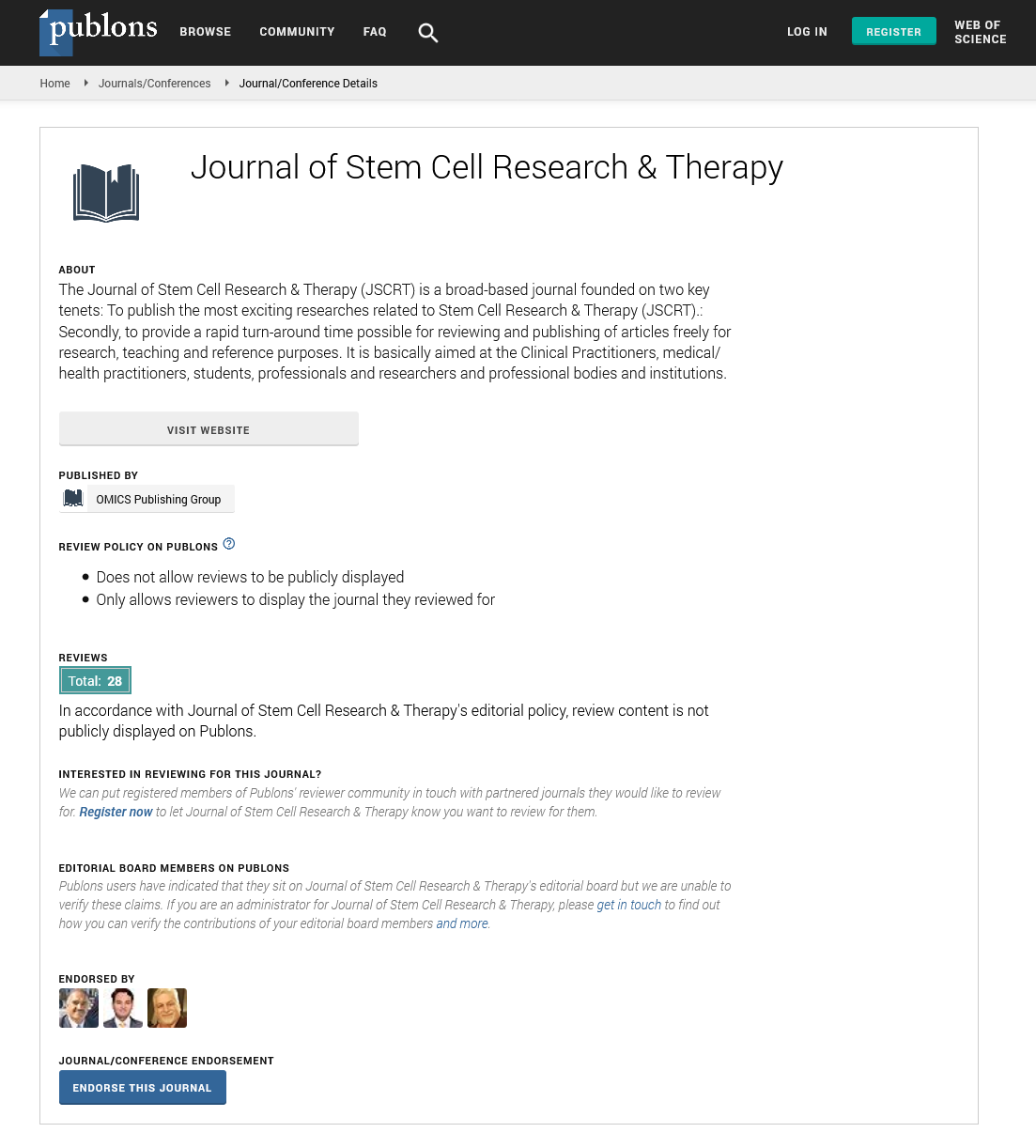Indexed In
- Open J Gate
- Genamics JournalSeek
- Academic Keys
- JournalTOCs
- China National Knowledge Infrastructure (CNKI)
- Ulrich's Periodicals Directory
- RefSeek
- Hamdard University
- EBSCO A-Z
- Directory of Abstract Indexing for Journals
- OCLC- WorldCat
- Publons
- Geneva Foundation for Medical Education and Research
- Euro Pub
- Google Scholar
Useful Links
Share This Page
Journal Flyer

Open Access Journals
- Agri and Aquaculture
- Biochemistry
- Bioinformatics & Systems Biology
- Business & Management
- Chemistry
- Clinical Sciences
- Engineering
- Food & Nutrition
- General Science
- Genetics & Molecular Biology
- Immunology & Microbiology
- Medical Sciences
- Neuroscience & Psychology
- Nursing & Health Care
- Pharmaceutical Sciences
Commentary - (2022) Volume 12, Issue 10
Pioneering Stem Cell Research and Advancements in Therapy
Fabian Gagne*Received: 03-Oct-2022, Manuscript No. JSCRT-22-18662; Editor assigned: 06-Oct-2022, Pre QC No. JSCRT-22-18662 (PQ); Reviewed: 20-Dec-2022, QC No. JSCRT-22-18662; Revised: 27-Oct-2022, Manuscript No. JSCRT-22-18662 (R); Published: 03-Nov-2022, DOI: 10.35248/2157-7633.22.12.558
Description
There are two main types of stem cells: embryonic stem cells, which come from early-stage embryos, and adult stem cells, which are found in various tissues throughout the body. Stem cells have the ability to self-renew, which means they can divide and make copies of themselves, as well as differentiate into specialized cell types. This unique combination of properties makes them potentially valuable for a wide range of therapeutic applications. Embryonic stem cells are derived from early stage embryos, typically from those that are three to five days old. These cells have the ability to differentiate into any type of cell in the body, which makes them invaluable for regenerative medicine. However, because they come from human embryos, their use is controversial and is currently only allowed in a limited number of countries.
Adult stem cells are found in various tissues throughout the body and can give rise to different types of cells depending on their location. For example, blood stem cells give rise to red blood cells, white blood cells, and platelets, while stem cells in the brain give rise to neurons and other types of brain cells. Adult stem cells have been used for many years to treat blood disorders and other conditions, and their use is much less controversial than that of embryonic stem cells. While stem cells hold great promise for the future of medicine, there are still many challenges that need to be overcome before they can be widely used in clinical applications. For example, researchers need to develop ways to safely and efficiently turn stem cells into the specific types of cells that are needed for each application. Additionally, large-scale clinical trials are needed to determine whether stem cell therapies are safe and effective.
In the past few years, there have been many breakthroughs in this field that have shown great promise in treating a variety of diseases and conditions. One of the most promising areas of research is in the area of regenerative medicine. This is where stem cells are used to repair or replace damaged tissue or organs.
This has the potential to help people who have suffered from conditions like heart disease, stroke, and even spinal cord injuries. Another area of research that is showing great promise is in the area of cancer treatment. There are many different ways that stem cells can be used to treat cancer, and researchers are constantly finding new and more effective ways to use them.
Overall, the future of stem cell research and therapy looks very bright. There are many different ways that stem cells can be used to improve the lives of people suffering from a variety of conditions. With continued research, we can only expect the number of ways in which stem cells can be used to help people to grow. The potential of stem cell research and therapy is vast. By harnessing the power of stem cells, we may be able to treat a wide variety of diseases and injuries. Additionally, stem cell research may help us to better understand how the human body works and develops. The capacity of stem cells to self-renew and specialize into multiple cell types makes them special. This means that, in theory, stem cells could be used to replace damaged or lost cells in the body. This has led to a great deal of excitement about the potential of stem cell therapy.
So far, stem cell therapy has been used to treat a number of conditions, including:
• Alzheimer’s disease
• Parkinson’s disease
• Spinal cord injuries
• Multiple sclerosis
• Diabetes
While the results of these treatments have been promising, it is important to note that stem cell therapy is still in its early stages. More research is needed to determine whether or not it is safe and effective for treating a wide range of conditions. Nonetheless, the potential of stem cell research and therapy is great. With further study, we may be able to develop new and improved treatments for a variety of diseases and injuries.
Citation: Gagne F (2022) Pioneering Stem Cell Research and Advancements in Therapy. J Stem Cell Res Ther. 12:558.
Copyright: © 2022 Gagne F. This is an open access article distributed under the terms of the Creative Commons Attribution License, which permits unrestricted use, distribution, and reproduction in any medium, provided the original author and source are credited.

